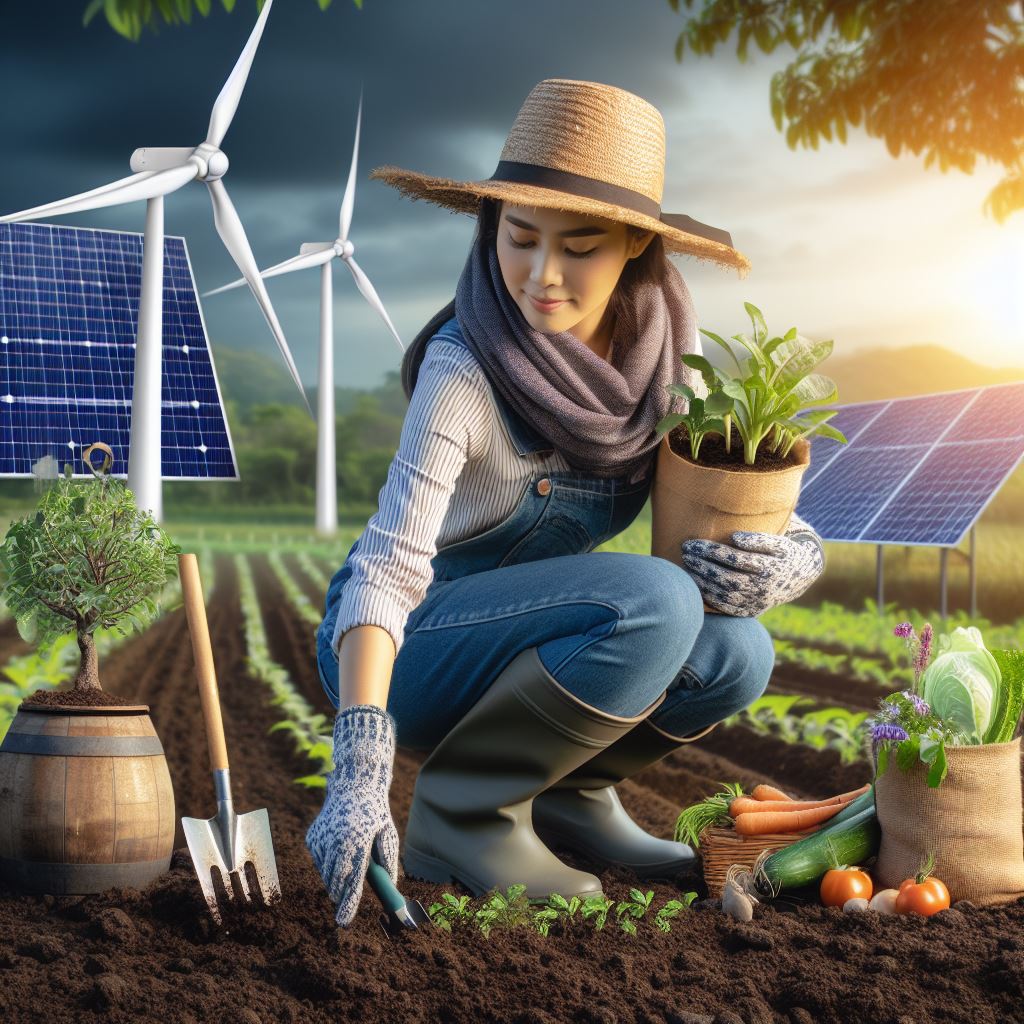Introduction
In dry climates, irrigation plays a crucial role in sustaining agriculture. Smart irrigation techniques are essential for efficient water use.
- Water Scarcity Challenge: Dry climates face water scarcity, making precise irrigation crucial for crop survival.
- Optimizing Water Use: Smart irrigation maximizes water efficiency, ensuring crops receive adequate moisture without wastage.
- Crop Health and Yield: Effective irrigation directly influences crop health and yields in arid regions.
- Resource Conservation: Smart techniques minimize water usage, aligning with sustainability goals and conserving precious water resources.
- Technology Integration: Innovative technologies, such as sensor-based systems and weather forecasting apps, enhance irrigation precision.
- Reducing Water Wastage: Traditional methods often lead to runoff and evaporation, wasting water crucial for plant growth.
- Tailored Irrigation: Smart systems deliver water directly to plant roots, avoiding unnecessary wetting of non-root areas.
- Adapting to Climate Variability: With climate changes, smart irrigation adapts, ensuring crops receive the right amount of water.
- Soil Moisture Monitoring: Regular monitoring prevents overwatering, promoting optimal soil moisture levels for plant growth.
- Drought Resistance: Smart irrigation contributes to crop resilience against drought conditions, supporting sustainable agriculture in dry climates.
In fact, embracing smart irrigation techniques is imperative for agriculture in dry climates.
Efficient water use not only supports crop health but also addresses the challenges posed by water scarcity.
The integration of technology and tailored approaches marks a significant stride towards sustainable and resilient farming practices in arid regions.
Understanding the Water Requirements
Types of crops suitable for dry climates
Understanding the water requirements for smart irrigation in dry climates is crucial.
By considering the types of crops suitable for such environments, one can maximize water conservation.
Choosing low water-demanding crops like cacti, succulents, and drought-resistant varieties is ideal.
Assessing soil condition and water-holding capacity
Assessing soil conditions and understanding its water-holding capacity is another important factor.
Conducting a soil test can provide information on moisture content, texture, and structure.
Soils with good water drainage and retention capabilities are preferable. Additionally, higher organic matter content in the soil promotes better water holding capacity.
Identifying evapotranspiration rates
Identifying evapotranspiration rates is essential for effective irrigation planning.
Evapotranspiration refers to the combined loss of water through evaporation and plant transpiration.
Calculating ET rates based on specific weather data, plant type, and crop coefficients can help estimate water requirements accurately.
Monitoring local weather conditions is crucial for determining ET rates.
Factors like temperature, humidity, wind speed, and solar radiation greatly influence water loss.
By keeping track of these variables, one can adjust irrigation schedules accordingly.
Using evapotranspiration data to estimate water requirements can optimize irrigation practices.
It helps ensure that plants receive adequate water while preventing excessive water usage.
By considering factors like crop water needs, weather conditions, and soil conditions, irrigation can be adjusted accordingly.
In short, understanding water requirements is essential for implementing smart irrigation techniques in dry climates.
Choosing suitable crops, assessing soil conditions, and identifying evapotranspiration rates are key steps.
By adopting these techniques, water conservation can be maximized while maintaining healthy and productive vegetation.
Read: Precision Agriculture: Tech in Crop Cultivation
Smart Irrigation Options
In dry climates, implementing smart irrigation techniques is essential for efficient water usage and maintaining healthy plants.
There are several options available for smart irrigation, each with its own benefits and considerations.
Drip irrigation
One popular option is drip irrigation, which involves delivering water directly to the base of plants through a network of tubes.
This technique promotes water conservation, reduces weed growth, and minimizes the risk of diseases.
Drip irrigation is particularly recommended for crops like vegetables, fruits, and flowers.
Sprinkler irrigation
On the other hand, sprinkler irrigation offers convenience and customization.
There are different types of sprinklers available, including oscillating, impact, and rotary sprinklers.
While sprinkler irrigation is suitable for covering larger areas, it has limitations such as water wastage due to evaporation and wind drift.
Choosing the right sprinkler system depends on factors like water pressure, area size, and plant type.
Soil moisture sensors
To ensure optimal water management, monitoring soil moisture is crucial.
Soil moisture sensors are available in different types, including volumetric, tensiometric, and capacitance sensors.
Proper installation and usage tips for soil moisture sensors include placing sensors at the appropriate depth and calibrating them regularly.
Weather-based irrigation controllers
Furthermore, weather-based irrigation controllers utilize weather data to optimize irrigation schedules and water usage.
Two common types of weather-based controllers are evapotranspiration-based and local weather station-based controllers.
These controllers offer benefits such as water savings, improved plant health, and reduced maintenance.
It is important to consider the accuracy of weather data and compatibility with existing irrigation systems when choosing a weather-based controller.
In general, smart irrigation techniques are crucial for efficient water usage in dry climates.
Drip irrigation, sprinkler irrigation, soil moisture sensors, and weather-based irrigation controllers offer various advantages and considerations.
Implementing these smart techniques not only conserves water but also promotes healthier plants and more sustainable farming practices.
Transform Your Agribusiness
Unlock your farm's potential with expert advice tailored to your needs. Get actionable steps that drive real results.
Get StartedRead: Cover Crops: Advantages in Crop Management
Gain More Insights: Understanding N-P-K Ratios in Fertilizers
Water Conservation Techniques
Water conservation is crucial in dry climates where access to sufficient water for irrigation purposes is limited.
Implementing smart irrigation techniques can significantly minimize water waste while maintaining healthy plants.
In this section, we will explore two important water conservation techniques: mulching and proper timing and scheduling.
Mulching
Mulching is a simple yet effective method for conserving water in dry climates.
By applying a layer of mulch around plants, you can reduce evaporation, suppress weed growth, and improve soil moisture retention.
- Benefits of using mulch: Mulch acts as a protective barrier, preventing water evaporation from the soil surface.
- Different types of mulch materials: Organic mulch, such as wood chips or straw, and inorganic mulch, such as gravel or rocks, serve as excellent options.
- Mulching tips for dry climates: Ensure the mulch layer is at least 3 inches thick and avoid piling it against the plant stems to prevent rot.
Proper mulching can reduce your water consumption by up to 50% and significantly improve the health of your plants.
Proper Timing and Scheduling
Timing irrigation correctly and establishing a well-planned schedule are essential for water conservation in dry climates.
By providing water when plants need it the most, you can maximize its effectiveness while minimizing waste.
- Timing irrigation for maximum efficacy: Water plants during the early morning or late evening when evaporation rates are lower.
- Creating an irrigation schedule: Consider factors like plant types, soil moisture levels, and climate conditions to determine the optimal frequency and duration of watering.
- Adapting to changing weather conditions: Be flexible with your irrigation schedule and adjust it based on rainfall, temperature changes, or extended periods of drought.
Establishing a consistent irrigation routine and adapting to fluctuations in weather conditions can help minimize water waste and ensure the health of your plants.
In review, implementing smart irrigation techniques is crucial for conserving water in dry climates.
By practicing mulching and proper timing and scheduling, you can significantly reduce water waste, promote soil moisture retention, and maintain the vitality of your plants.
These techniques not only contribute to environmental sustainability but also save you money on water bills.
Start applying these water conservation methods in your garden today and make a positive impact on the health of your plants and the planet.
Read: Techniques for Healthy Soybean Growth

You Might Also Like: Natural Pest Control in Farming
Maintenance and Troubleshooting
Regular System Check-ups
Regular system check-ups are essential to keep your smart irrigation system running efficiently.
By inspecting various components regularly, you can identify any issues and address them proactively.
1. Inspecting Irrigation Components
Check all the parts of your smart irrigation system, including pipes, valves, sprinkler heads, and filters.
Look for any signs of damage, such as cracks or clogged filters. Clean or replace any faulty components to ensure proper water flow.
2. Fixing Leaks and Drips
Leaks and drips are a common problem in any irrigation system.
They not only waste water but can also lead to landscape damage.
Regularly inspect all connectors, valves, and sprinkler heads for leaks.
Repair or replace any faulty parts promptly to prevent further damage.
3. Adjusting Sprinklers for Optimal Coverage:
Proper sprinkler coverage is crucial for efficient irrigation.
Check that all sprinkler heads are working correctly, without any blockages or misalignment.
Adjust the spray patterns and direction to ensure even distribution of water throughout the landscape.
Troubleshooting Common Issues
While regular maintenance helps prevent most issues, troubleshooting is sometimes necessary to resolve specific problems with your smart irrigation system.
1. Identifying and Resolving Clogs
If you notice that your system’s water flow is reduced or uneven, there may be clogs in the pipes or sprinklers.
Check and clean the filters, unclog any obstructions, and ensure proper water flow throughout the system.
2. Addressing Low Water Pressure
If you experience low water pressure in certain areas of your irrigation system, check for any blockages or leaks that could be causing the issue.
Adjust the valves, remove any debris, and ensure proper water pressure throughout the system.
3. Dealing with Over or Underwatering
If you observe dry patches or excessive water runoff, your system may be over or underwatering certain areas.
Adjust the watering schedule and duration based on weather conditions and the specific needs of your plants.
Consider installing moisture sensors or a weather-based controller to optimize water usage.
Maintaining and troubleshooting your smart irrigation system regularly is crucial for its effective and efficient operation.
By addressing any issues promptly and fine-tuning the system settings, you can ensure optimal water usage and a healthy landscape even in dry climates.
Read: Drip Irrigation: Saving Water in Crop Fields
Conclusion
Embracing smart irrigation techniques is pivotal for sustainable agriculture in dry climates.
Recap the significance
- Water Conservation: Smart irrigation minimizes water wastage, ensuring optimal use in water-scarce regions.
- Crop Health: Improved irrigation methods enhance crop health, leading to better yields and quality.
- Resource Efficiency: Smart techniques optimize resource usage, reducing environmental impact and conserving energy.
The benefits for farmers in dry climates are substantial
- Increased Productivity: Smart irrigation contributes to higher crop yields, securing farmers’ livelihoods.
- Cost Savings: Efficient water use results in reduced costs associated with water consumption and energy usage.
- Sustainability: Adopting smart techniques aligns farming practices with environmental sustainability, meeting global standards.
Encouraging adoption and implementation involves
- Awareness: Spread awareness about the advantages of smart irrigation through workshops, seminars, and outreach programs.
- Training: Provide training sessions for farmers on the installation and management of smart irrigation systems.
- Incentives: Governments and organizations can offer financial incentives to encourage the adoption of these techniques.
- Collaborations: Foster partnerships between agricultural experts, technology providers, and farmers to facilitate knowledge exchange.
- Policy Support: Advocate for policies that promote the use of smart irrigation, recognizing its role in sustainable agriculture.
By integrating these strategies, farmers can navigate challenges posed by water scarcity, enhance productivity, and contribute to a more sustainable future.
Embrace smart irrigation, and let innovation transform agriculture in dry climates.




